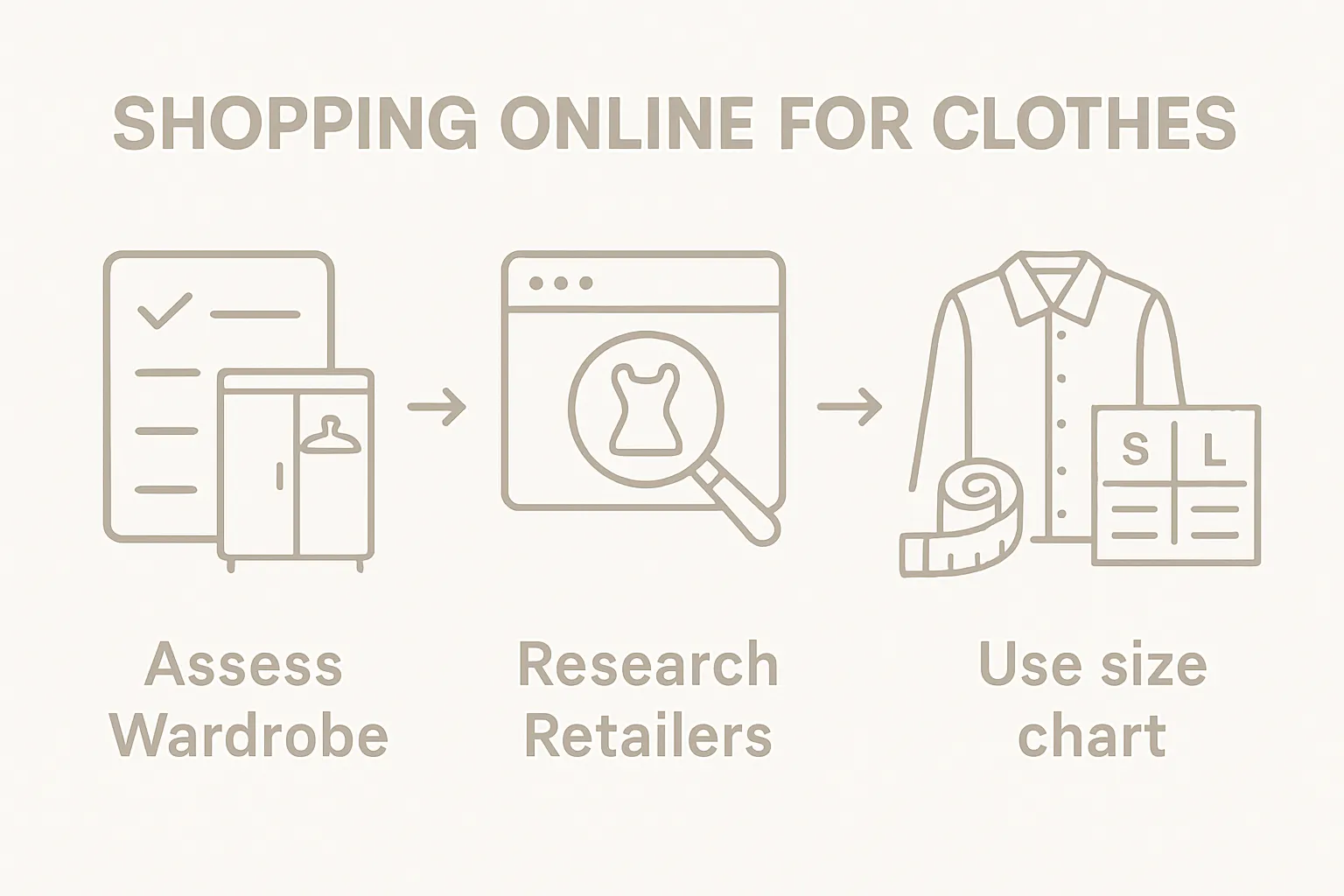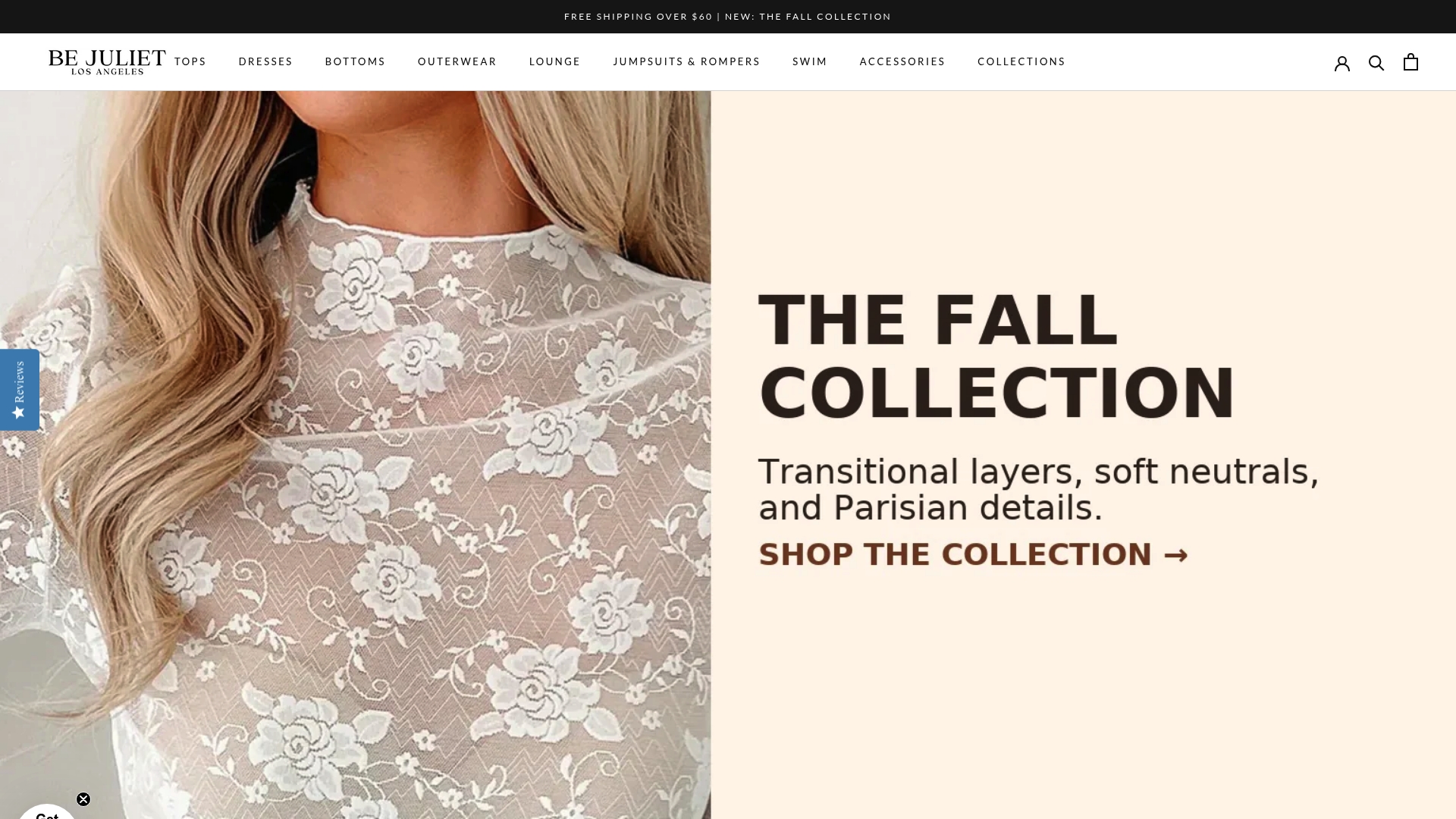How to Shop Online for Clothes: A Complete Guide for Women
Shopping for clothes online can feel overwhelming when every click brings a flood of choices and endless scrolling. One surprising fact is that about 30 percent of online clothing purchases end up being returned, showing just how tough it is to get it right the first time. Most people think the problem is only about picking the right size or finding a good deal, but the real secret is that success starts with how you prepare before you even add anything to your cart.
Table of Contents
- Step 1: Assess Your Wardrobe Needs
- Step 2: Research And Select Trusted Online Retailers
- Step 3: Utilize Size Charts And Filters Effectively
- Step 4: Add Items To Your Cart And Compare Choices
- Step 5: Review Your Cart And Apply Discounts Before Checkout
- Step 6: Track Your Items And Plan For Returns If Necessary
Quick Summary
| Key Point | Explanation |
|---|---|
| 1. Assess your wardrobe before shopping | Understand current gaps and styles to make intentional purchases. Evaluate what you need to avoid unnecessary spending. |
| 2. Research trusted online retailers | Check customer reviews, sizing info, and return policies to ensure a positive shopping experience. Choose retailers carefully based on performance. |
| 3. Use size charts and filters wisely | Accurate measurements and effective filtering can enhance fit and reduce returns. Utilize these tools to streamline your search. |
| 4. Compare choices before purchasing | Avoid impulse buying by evaluating similar items across different platforms. Use a waiting period for better decision-making. |
| 5. Review cart and apply discounts | Check item compatibility with your wardrobe and search for discounts before checking out. This helps in making financially sound choices. |
Step 1: Assess Your Wardrobe Needs
Before diving into online shopping for clothes, understanding your current wardrobe is fundamental to creating a strategic and intentional shopping experience. Wardrobe assessment helps you make smart purchasing decisions, prevent unnecessary spending, and build a cohesive collection that truly reflects your personal style.
Starting your wardrobe evaluation requires a systematic and honest approach. Begin by completely emptying your closet and laying out every clothing item you own. This physical process allows you to see your entire wardrobe at once, making it easier to identify gaps, redundancies, and potential opportunities for improvement. Sort your clothing into clear categories: items you wear frequently, pieces that need repair, seasonal clothing, and garments you haven’t worn in the past year.
Conducting a thorough inventory involves more than just counting pieces. Consider the functionality of your current wardrobe. What occasions do you dress for most often? Are there specific work, casual, or social events where you feel your clothing options are limited? Assess the color palette, versatility, and mix-and-match potential of your existing pieces. A strategic wardrobe isn’t about quantity but about having the right items that can be styled multiple ways.
Here is a checklist table to help you systematically assess your wardrobe needs before shopping online for clothes.
| Assessment Step | What to Do | Why It Matters |
|---|---|---|
| Empty your closet | Remove all items and lay them out | Provides a clear view of your wardrobe |
| Categorize items | Sort into frequently worn, repair, seasonal, unworn | Identifies gaps and redundancies |
| Evaluate functionality | Consider what occasions you dress for | Ensures practical wardrobe additions |
| Assess mix-and-match | Review color palette and versatility | Helps create a cohesive style |
| Catalog inventory | Use apps or spreadsheets to track clothing | Supports strategic shopping decisions |
| List wardrobe gaps | Write down genuinely needed items | Guides intentional purchasing choices |

Technology can be an incredible ally in this process. Use smartphone apps or spreadsheet tools to catalog your clothing, track wear frequency, and identify potential purchasing needs. Some digital tools even allow you to create virtual outfit combinations, helping you understand what missing pieces might elevate your existing collection. Research suggests that conscious wardrobe assessment can significantly reduce unnecessary fashion consumption.
As you complete your assessment, create a clear list of items you genuinely need. Focus on versatile pieces that complement your existing wardrobe and align with your lifestyle. Check out our guide to creating a perfect capsule wardrobe for additional insights into building a streamlined, functional clothing collection. Remember, the goal isn’t to completely overhaul your wardrobe but to make intentional, thoughtful additions that enhance your personal style and daily comfort.
Step 2: Research and Select Trusted Online Retailers
Selecting reliable online retailers is a critical step in your digital shopping journey, forming the foundation of a safe and satisfying clothing purchasing experience. Not all online stores are created equal, and understanding how to identify trustworthy platforms can save you time, money, and potential frustration.
Begin your research by examining comprehensive customer reviews and ratings across multiple platforms. Websites like Trustpilot, Consumer Reports, and independent fashion blogs often provide unbiased insights into retailer performance. Pay close attention to feedback about product quality, sizing accuracy, shipping reliability, and return policies. A reputable online retailer should offer transparent sizing charts, detailed product descriptions, and multiple customer support channels.
Consider establishing a set of non-negotiable criteria when evaluating online clothing stores. Look for retailers that provide high-resolution product images from multiple angles, offer detailed fabric composition information, and have clear size guides that help you make informed purchasing decisions. According to research on online consumer behavior, detailed product information significantly reduces return rates and increases customer satisfaction.
Technology can be an excellent ally in your retailer selection process. Utilize comparison websites and shopping platforms that aggregate reviews, prices, and seller ratings. Browser extensions can help track price fluctuations and provide additional consumer protection insights. Some advanced tools even offer predictive sizing recommendations based on your body measurements and previous purchase history.
For additional style guidance and retailer recommendations, check out our style tips for petite women, which can help you navigate online shopping challenges specific to your body type. Remember that building a trusted roster of online retailers is an ongoing process. Stay flexible, continue researching, and don’t hesitate to explore new platforms that align with your personal style and shopping preferences.
The following table summarizes essential criteria for evaluating and selecting trusted online retailers when shopping for clothes.
| Retailer Evaluation Criteria | Why It Matters | What to Look For |
|---|---|---|
| Customer reviews | Gauge reliability and satisfaction | Look for positive, detailed feedback |
| Sizing info | Reduces fit-related returns | Transparent size charts, measurements |
| Product descriptions | Ensures accurate expectations | Fabric details, care instructions |
| Return policies | Simplifies problem resolution | Clear, fair, and flexible policies |
| Customer support | Offers help for issues and questions | Multiple, responsive contact channels |
Step 3: Utilize Size Charts and Filters Effectively
Navigating online clothing shopping requires mastering the art of using size charts and digital filters with precision and confidence. These tools are your secret weapons in finding the perfect fit and narrowing down overwhelming clothing options to exactly what suits your style and body type.
Precise measurement is the cornerstone of successful online clothing shopping. Before engaging with any size chart, invest time in accurate body measurements. Use a flexible measuring tape and have someone assist you for the most precise results. Measure your bust, waist, hips, and inseam while wearing well-fitting, minimal undergarments. Different brands often have slightly varied sizing, so always consult the specific retailer’s size chart rather than assuming standard measurements.
Digital filters transform online shopping from an overwhelming experience to a streamlined selection process. Most reputable online retailers offer multiple filtering options including size range, color, price point, style, and fabric composition. Learn to stack these filters strategically. For instance, if you know you prefer midi-length dresses in solid colors within a specific price range, combine those filters to instantly eliminate unsuitable options. Some advanced platforms even offer body type matching algorithms that recommend styles most likely to flatter your specific proportions.
Research on consumer online shopping behavior demonstrates that effective use of size and style filters can reduce return rates by up to 30%. This means not only saving time but also reducing the environmental impact of clothing returns. Pay special attention to fabric composition filters, which can help you select materials that align with your comfort preferences, climate needs, and maintenance capabilities.
For additional insights into personalizing your online shopping experience, check out our guide on styling for different body types. Remember that mastering size charts and filters is a skill that improves with practice. Be patient with yourself, take detailed measurements, and don’t hesitate to reach out to customer service if you’re uncertain about sizing or fit recommendations.
Step 4: Add Items to Your Cart and Compare Choices
Adding items to your cart and strategically comparing choices transforms online shopping from a passive browsing experience into an intentional selection process. This step is about creating a thoughtful collection of potential purchases that align with your wardrobe needs and personal style.
Digital window shopping requires a disciplined approach. Start by opening multiple browser tabs or windows to compare similar items across different retailers. Look beyond just the price tag and examine details like fabric composition, care instructions, and subtle design variations. Some advanced shoppers use spreadsheet tools to track item specifications, prices, and potential outfit combinations. This methodical approach helps prevent impulse purchases and ensures you select pieces that truly complement your existing wardrobe.
When adding items to your cart, resist the temptation to immediately checkout. Instead, treat your cart as a curated collection zone where items can be carefully evaluated. Many online retailers now offer wishlist or save-for-later features that allow you to park items without commitment. Create a 24-hour waiting rule where you review cart contents after a day, allowing emotions to settle and rational decision-making to take over. Research on consumer behavior demonstrates that this cooling-off period can reduce unnecessary spending by up to 40%.
Technology offers remarkable tools to enhance your comparison process. Browser extensions can track price changes, provide coupon codes, and even estimate total costs including potential taxes and shipping. Some platforms offer virtual try-on technologies or detailed sizing recommendations based on your previous purchases. For those seeking additional style guidance, our petite styling guide can help you make more informed choices during this comparison stage.
Ultimately, successful cart management is about balance. Select items that not only look appealing but also integrate seamlessly with your existing wardrobe, represent good value, and align with your personal style goals. Your cart should reflect a curated collection, not a random assortment of impulse purchases.
Step 5: Review Your Cart and Apply Discounts Before Checkout
The final stages of online clothing shopping demand careful attention and strategic financial planning. Reviewing your cart and applying discounts is not just about saving money, but about making informed, responsible purchasing decisions that align with your budget and wardrobe needs.
Systematic cart review begins with a comprehensive item assessment. Carefully examine each piece in your cart, verifying that they genuinely complement your existing wardrobe and meet the style and functionality requirements you established earlier. Ask yourself critical questions: Does this item fill a specific wardrobe gap? Can it be styled in multiple ways? Is the price justified by the potential versatility and quality of the piece?
Discount hunting requires a methodical approach. Before finalizing your purchase, conduct a thorough search for promotional codes, seasonal sales, and potential cashback opportunities. Browser extensions and coupon websites can automatically surface relevant discounts. Some credit cards and online banking platforms offer additional cashback or rewards for online purchases, providing an extra layer of savings. Research indicates that strategic discount application can reduce overall clothing expenses by up to 25%.
Shipping costs and return policies are crucial considerations that can significantly impact your total purchase value. Some retailers offer free shipping above a certain purchase amount, so strategically adding or removing items can sometimes reduce overall costs. Pay close attention to return policies and potential restocking fees. Our free unlimited return policy can provide additional peace of mind during your online shopping experience.
Before clicking ‘checkout’, perform a final inventory check. Ensure all items are the correct size, match your initial wardrobe assessment criteria, and represent genuine value. A moment of patient review can prevent costly impulse purchases and buyer’s remorse. Your goal is a curated, intentional collection that enhances your personal style while respecting your financial boundaries.

Step 6: Track Your Items and Plan for Returns if Necessary
Online clothing shopping does not end with the checkout process. Tracking your items and preparing for potential returns is a critical aspect of a successful digital shopping experience that ensures your satisfaction and protects your investment.
Create a dedicated tracking system for your online clothing purchases. Most retailers provide tracking numbers and estimated delivery dates, but establishing a personal method can help you stay organized. Consider using a spreadsheet or dedicated mobile app to log purchase details, including order dates, expected delivery windows, and specific item information. This approach not only helps you monitor incoming packages but also provides a comprehensive record of your shopping history.
Research indicates that approximately 30% of online clothing purchases result in returns, making return preparedness essential. Familiarize yourself with each retailer’s specific return policy before completing your purchase. Some stores offer free returns, while others might charge restocking fees or require items to be in unworn, original condition with tags attached. Carefully read and understand these guidelines to avoid unexpected expenses or complications.
Technology offers numerous tools to streamline your package tracking experience. Most shipping carriers have mobile apps that provide real-time updates, and many retailers offer integrated tracking systems directly through their websites. Set up email or text notifications to receive instant updates about your shipment’s progress. Proactively addressing potential sizing or style issues can save significant time and frustration. If an item seems problematic upon arrival, initiate the return process promptly to ensure you remain within the retailer’s return window.
For travelers and those with dynamic lifestyles, strategic planning becomes even more crucial. Our guide to packing light offers additional insights into managing clothing purchases and returns while maintaining a flexible wardrobe. Remember that successful online shopping is about creating a seamless, stress-free experience that allows you to confidently expand and curate your personal style.
Curate Your Dream Wardrobe with Be Juliet
You have learned how to assess your closet, master online size charts, and navigate the world of virtual shopping carts. Now it is time to bring your style vision to life with clothing that genuinely celebrates every side of you. At Be Juliet, you never have to choose between comfort, confidence, and authenticity. From cozy Sweaters & Sweatshirts for those tranquil moments at home, to statement pieces like our Corsets / Bustiers for when you want to feel powerful, our collection lets every woman express her own language of love and style.

Why wait to redesign your closet into a source of daily inspiration? Find pieces that fit your life and soul at Be Juliet. Browse our curated collections now and discover wardrobe essentials made to last, empower, and support your personal evolution. Let your next fashion chapter start today.
Frequently Asked Questions
How do I assess my current wardrobe before shopping online for clothes?
Begin by emptying your closet and categorizing each item into groups such as frequently worn, needs repair, seasonal, and unworn items. This helps identify gaps and redundancies, allowing you to focus on versatile pieces that enhance your personal style.
What are the key factors to consider when selecting online retailers?
Look for retailers with comprehensive customer reviews, transparent sizing charts, detailed product descriptions, and good return policies. Pay attention to product quality, shipping reliability, and customer support.
How can I accurately use size charts while shopping online?
Take accurate body measurements using a flexible measuring tape and consult the specific retailer’s size chart instead of relying on standard sizes, as different brands may have varying dimensions.
What should I do if I need to return an item purchased online?
Familiarize yourself with the retailer’s return policy before purchasing. Keep track of your purchases and initiate the return process promptly if an item doesn’t meet your expectations or fit correctly.
Recommended
- Top 5 Fashion Mistakes and How to Fix Them For Women! – Be Juliet
- Spring Casual Outfits for Ladies to Enhance Your Style – Be Juliet
- Dressing for Your Body Type: Fashion Tips for 2025 – Be Juliet
- Understanding Fashion Mistakes to Avoid for Women – Be Juliet
- 6 Types of Women’s Fashion Styles to Explore Today – DARK Femme
- Understanding Key Terms for Women’s Fashion Explained – DARK Femme
